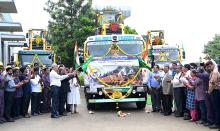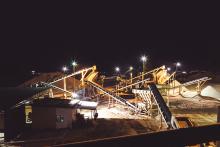Partha Pratim Basistha reports on a period of change in the Indian aggregates and construction equipment industries - in a report by our sister title Aggregates Business.
India’s construction equipment and aggregates sectors are passing through an interesting phase. Despite demand fundamentals remaining firm, under the recent directives of India’s main Central Reserve Bank state-managed banks and non-banking financial institutions are releasing less finance to construction companies, quarry owners, and equipment rental agencies. This has slowed down equipment acquisitions. This year’s extended monsoons have been a further demand dampener for earthmoving equipment and rigid dump truck sales. The hardening financial assistance stance is due to large volumes of non-performing assets accumulated over recent years.
Due to tightening financial support for new equipment purchases and the general running of operations, plant and machinery owners are increasingly seeking new equipment models that are cost-effective to own and operate. They are, however, willing to invest in advanced levels of service support from original equipment manufacturers (OEMs) and dealers that can result in higher levels of existing equipment utilisation and help keep operating costs in check. As a result, Indian and foreign equipment manufacturers are tailoring their product and service offerings accordingly.
Ashoktaru Chattopadhayay, Sandvik’s global business development manager- Crushing & Screening Plants Solutions, said the company is increasingly entering into operational contract support for its plant owners. “Backed by this support, they are able to park or timely arrange for funds for carrying out their operation maintenance schedule. It allows for timely procurements of parts, the taking care of wear and tear and for higher availability of plants. Our support also helps customers to keep their capital and operational expenditure under control.”
Sandvik India is providing an operational support contract to J.M. Mahtre, one of India’s biggest road contractors, which is helping to build Navi Mumbai International Airport, in Mumbai, Western India. The airport is due to become operational in 2023. On the infrastructure megaproject, J.M. Mahtre is deploying 12 Sandvik plant with capacities ranging between 200 and 400 tonnes per hour. The fleet includes a mix of CJ 211 cone crushers, CJ 409 jaw crushers, and CH 430, CH 440 and CH 550 cone crushers.
Metso India is also working towards reducing the costs of customer plant operations by offering higher additional-value services support. “Backed by a mix of our annual maintenance and operational services contracts, which is based on our philosophy of life cycle offerings, plant owners in India with Metso solutions can focus on the core business of marketing their aggregates,” said Pekka Vauramo, Metso president & CEO, during an interview with ABI during his recent visit to inaugurate Metso’s extended plant in Alwar, Rajasthan, Northern India.
Newer business strategies to reduce ownership costs via product reengineering and a wider product portfolio, coupled with newer services, are becoming the norm among Indian crushing and screening manufacturers.
Propel Industries, a major Indian manufacturer of mobile and stationery crushing and screening plant and solutions for manufactured sand production, has recently set up a state-of-the art facility for manufacturing tracked plant in Coimbatore, South India.
V. Senthil Kumar, the company’s managing director, said: “The character of Indian rocks is quite different and varies from region to region. We have been carrying out design improvisations to suit local plant owner requirements, while also fully ensuring the right cubicle shape of the crushed aggregates to deliver better strength. Led by our strong engineering integration, beginning with the designing of the plants to manufacturing, we are able to provide international solutions at Indian prices.” Propel has recently been exporting its plant to Middle East markets.
The digitisation of products and services via the internet of things (IoT) is an emerging trend, helping curtail costs of plant operation in India. Equipment owners are increasingly looking to maximise output from existing solutions, delaying fresh acquisitions due to tighter access to banking and non-banking institution finance.
Hitachi ZAXIS GI series excavators in India now come with Global e-Service – a platform developed by Hitachi, Japan. It includes a premium offering called ConSite, which is offered as standard with all GI machines. ConSite uses comparative data of similar class machines operating in the region to provide insightful advice and recommendations to improve operations. There is also an alarm service which uses machine events and acts as an intelligent filter to communicate machine breakdown and raise alarms with unit owners and their dealers.
Volvo India’s CareTrack excavator telematics system gives equipment owners access to a wide range of machine monitoring information, enabling higher model utilisation.
KOMTRAX (Level-3) for Komatsu excavators monitors machine health, watches performance and provides economical operation guidance to operators. Besides basic data like machine location and operating hours, it provides vital information on fuel consumption, mode selection, energy saving and guidance, while also tracking maintenance schedules and offering timely alerts. Telematics has been beneficial for larger-sized quarry owners and ready-mixed concrete plant operators with sizeable equipment fleets.
Saurabh Agarwal, director, LSC Group, said: “Telematics has been extremely advantageous for us with operating margins under greater pressure. We have our centralised office at Rudrapur in Uttarkhand, North India, with plants operating across nine locations. Volvo’s IT-enabled Matris solution in our excavators enables us to centrally access real-time data on fuel consumption, idling hours and switch-off time. It allows us to keep operating costs in check and optimise excavator usage on-site. Telematics solutions offered by Hitachi and Liugong have also been beneficial.”
LSC was the first crushing plant owner to acquire LiuGong’s H-Series intelligent wheeled loaders for its Uttarakhand facility.
Ashok Leyland, an Indian heavy commercial vehicle and tipper truck manufacturing major with a strong presence on quarrying and cement plant sites across the country, has digital initiatives to increase the availability of its trucks, thus increasing customers’ profitability.
Mullagiri Surendranath, Ashok Leyland vice president, said: “Under our ‘I-Alert’ digital telematics solutions, our individual customers and, most importantly, fleet owners, will be acquainted on a real-time basis with the various operating conditions of their trucks. This includes fuel consumption and trip cycle times. This greatly assists with quicker redeployment of the tipper if found idling. Quicker redeployment is a vital requirement in the newer, bigger capacity cement plants. With various codes being generated in case of functional anomalies, I-Alert will also facilitate preventive and predictive maintenance and help encourage safer utilisation of the trucks, as driver shortcomings, like fast driving on sharp bends, harsh braking, and fatigue, can be gauged and acted upon.”
in January 2019, Volvo Trucks India set up a Centralised Uptime Centre in Bangalore, South India. The centre offers an extensive end-to-end, real-time product services programme based on analysis through telematics, utilising the remote diagnostics of Volvo trucks to enable their timely maintenance and repair.
V. Venkateswarlu, vice president, Aftermarket, Volvo Trucks India, said: “The centre gathers real-time information on where and how the trucks are working. The information is then analysed, and measures are suggested to rectify the problem. Monitoring is done on the driving pattern of the operators to see whether advanced features of our trucks, such as advanced I-Shift transmissions, are being utilised to optimise performance. Braking frequencies are also monitored, as frequent braking can bring pressure on the axles.
“Since our trucks are engineered to deliver faster cycle times, the centre monitors their unloading time and number of trips made. In case of reduced cycle times, possible reasons like unwarranted operator behaviour and probable breakdown are taken into consideration. Following this, a dedicated cross-functional team at the centre analyses the causes and works out the required solution. Based on the record of the vehicle’s utilisation rate, the centre will communicate back to the vehicle on preventive and predictive maintenance needs, along with an advice on parts replacements.”
There are 12 Volvo Trucks Uptime Centres in India. The centres extend knowledge support to their customers and dealers. The Centralised Command Centre in Bangalore gathers information from various centres and recommends proactive and reactive services.
The Command Centre is presently monitoring 5,800 Volvo Trucks India models. Trucks sold by Volvo India since 2014 have been assimilated with the centre’s digitised monitoring system.
Volvo Penta will use its tried and tested selective catalytic reduction (SCR) technology for Indian OEMs when the stringent BS CEV IV emission norms come into effect in India in October 2020. The major engine maker has products ready for the BS CEV IV in off-highway applications.
“Since mid-2019, we have been working with several customers and OEMs on BS CEV IV-compliant engines. We undertake extensive field-testing on engine performance, installation and application, including in the most abusive field conditions for thousands of hours so that we can develop robust engines.
“With the stringent emission regulations, all the engine suppliers will have to move to electronic engines with an after-treatment system. In fact, Volvo Penta had introduced electronically controlled engines in 2006 in India, independent of the emission regulations. Along with a cleaner environment, the machine owner and operator benefit from a lower cost of ownership, greater reliability and stable operations over the lifetime of the engine,” said Miron Thoms, vice president & head - Volvo Penta India.
Kirloskar Oil Engines Ltd. (KOEL) is a major Indian on- and off highway engine manufacturer that supplies its solutions to leading Indian and foreign OEMs in India.
Sanjeev Nimkar, KOEL chief operating officer, said: “Kirloskar Oil Engines has initiated field trials for its BS IV engines for use in backhoe loaders, compactors, wheeled loaders, motor graders, self-loading concrete mixers and cranes. These are all complied with stringent BS IV emissions in Phase I, and for excavators which will have to comply in Phase II. Our new BS1V engines will provide the same ease of operation, fuel efficiency, robustness, durability and reliability that Kirloskar engines are known for.”
While there are stronger, concerted initiatives on behalf of equipment manufacturers and owners towards reducing owning and operating costs of equipment, stakeholders, government agencies, project owners and developers are increasingly looking to deliver more ecologically-minded and sustainable road construction projects.
Sanjeev Kumar, chief engineer at India’s Union Ministry of Road Transport and Highways (MoRTH), said: “The ambitious target of constructing 15,000 kilometres of National Highways by 2020 has led to a colossal consumption of aggregates, estimated to be about 150 million tonnes. This is despite India’s National Highways constituting only two per cent of the total road network. Though construction of roads is indispensable for any growing economy, there is a dire need to curtail exploitation of natural resources and reduce greenhouse gas emissions during road construction projects. To make this happen it will be essential to recycle and reuse bituminous materials, backed by milling technologies.”
MoRTH has issued guidelines on the utilisation of recycled materials, in which it stresses the use of fly ash. The Indian Road Congress has also framed guidelines on the usage of waste plastic, with 350 kilometres of roads being identified for this purpose. Through this utilisation of geosynthetic materials, dependence on virgin aggregates can be largely reduced.
Sharing India’s Central Road Research Institute’s (CRRI) blueprint for sustainable road construction, Dr. Satish Chandra, director, CRRI, said: “As availability of aggregates is reducing fast, Indian Road Congress IRC 37 2018 guidelines stipulates usage of polymer stabiliser mixed with base course materials. To curtail usage of aggregates, it is essential to use hot and cold recycling for road rehabilitation projects. CRRI has recently undertaken some critical research on cement grouted bituminous mix (CGBM). The advantages of CGBM are wide, as its life cycle is longer than bituminous concrete.”
Dr. Chandra continued: “We have recently looked at the use of steel slag on the Ranchi-Jamshedpur (Eastern India) highway rehabilitation. We have also conducted studies of the utilisation of ferrochrome as a provider of greater [highway] strength.”
According to Dr. Chandra, MoRTH will soon be announcing more waste plastic and slag for highway rehabilitation trials. He added: “CRRI can be a suitable partner to this venture as Tata Steel has approached us for utilisation of waste slag.”







